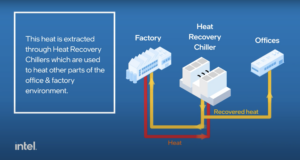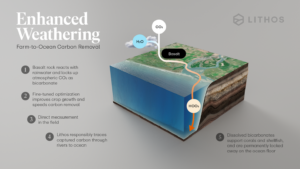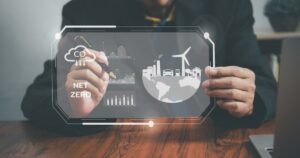In a warming world, extreme weather events cause more damage and economic losses than ever before. They’re one of the most visible impacts of climate change and one of the largest threats to business operations. Already this year, according to the National Oceanic and Atmospheric Administration, through the first nine months of 2021, the U.S. experienced 18 separate $1 billion disasters, including wildfires, hurricanes and heat waves. (The year before hit a record 22, while the record prior to that was 16 in 2017 and 2011.)
At GreenBiz’s annual cleantech conference last week, VERGE 21, executives from companies across sectors discussed how they are looking for ways to not only predict these extreme events, but also to prepare for them.
It’s no easy task — conventional weather forecasting strategies based on historical averages of weather and climate data can’t keep up with the current levels of climate variability. The past is no longer a predictor of the future.
Instead, companies are turning to new technologies and improved risk assessments to adapt to the unwieldy impact of climate change and to mitigate future impacts.

![]()
![]()
![]()
![]()
![]()
![]()
The challenges of assessing extreme weather risk factors
Good risk management in the climate change era requires precise knowledge of the factors that influence extreme weather risks, such as exact geographic location data, full asset inventories and emissions scenarios.
As Kelly Hereid, director of catastrophe research and development at Liberty Mutual Insurance, said in a session on future-proofing physical infrastructure, “Climate hazards require high-resolution location data. The risks may change a lot over small spatial areas.”
She gave one example of a data problem that she grapples with: street grid views of maps. If you put an address into a map, it will often give you the exact coordinates of that house’s mailbox in front of the house on the street level — but the street might be at a lower or higher elevation and have trees and power lines near it compared to the actual house, all of which affect risk level. That leaves blindspots in understanding how such properties will fare during floods or even against sea level rise.
Hereid called for even more granular data and better tools that can more quickly respond to emerging weather situations — data on both the space and time scales are important, she said.
During such emergency weather situations, though, one of the most important pieces of data is if the asset at risk has been well-maintained.
Michael Kilpatrick, head of state government, municipal and co-op division at Duke Energy Sustainable Solutions, agreed, posing questions such as: Will a company’s’ factories’ pumps work in a flood? Will the backup generators turn on during a storm? Will the evacuation system set up for a wildfire alert local employees and their families in time?
Infrastructure is “only as good as you maintain it,” he added.
He pointed out that solutions are needed to understand how critical your operations are and how much risk your company can assume on a case-by-case basis depending on the sector. For example, for a gadgets factory, if an extreme weather event occurs you can shut down and receive an insurance payout if a disaster happens, he said. But if your company is a hospital, you can’t go down.
“It’s about assessing your unique circumstances and being more forward-looking about what’s happening now and what could happen in the future,” he said.
How companies can prepare for extreme events
Companies often build their own tools, or turn to startups for tools to predict weather risk. Kilpatrick noted that companies and cities “need to be open to new technology,” such as alternative fuels, battery storage and others.

![]()
![]()
![]()
![]()
![]()
![]()
Megan Saunders, director of sustainability at Lendlease Communities, which builds houses and apartment buildings, also told the VERGE audience about how Lendlease considers climate risk in its investment decisions.
“We look at long-term chronic and acute [risks],” she said.
Lendlease has built its own finance-risk model that shows risks to properties under future climate scenarios. It gives more insight over the next century, which is “the lifecycle of a building.”
Hereid said that Liberty Mutual has invested in Jupiter Intelligence, a climate analytics company, to deepen their data and insights. The ultimate goal? To expand Liberty Mutual’s risk advisory role for partners and clients, and reduce risk for the insurance company all around.
But reducing extreme weather climate risks also means tackling climate change head-on and drawing down emissions from the atmosphere.
According to Saunders, Lendlease has reported its climate-related risks and opportunities following the framework of Task Force for Climate Disclosure (TCFD) since 2018. (The organization TCFD has developed consistent climate-related financial risk disclosures for companies, banks and investors to use in order to provide relevant information to stakeholders.) Saunders said that the company understood that not only was cutting its own emissions crucial for tackling climate change, but also, this information and transparency was crucial to its investors.
It’s a dual challenge to cut emissions while also preparing for a climate change future.
“How do you provide climate-proof resiliency while transitioning to a decarbonized future?” Kilpatrick said.
Source: https://www.greenbiz.com/article/extreme-weather-risk-companies-heres-how-theyre-preparing









